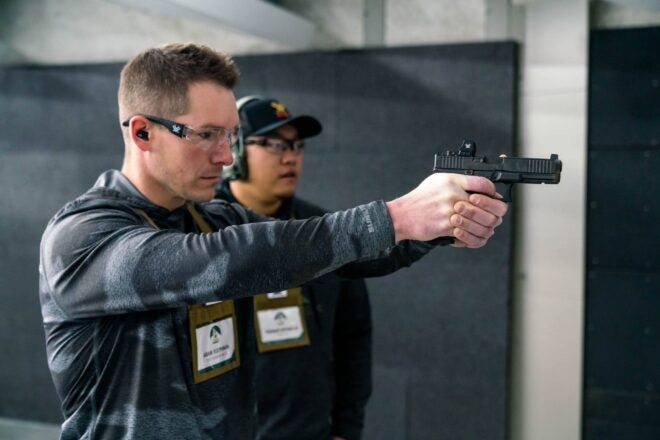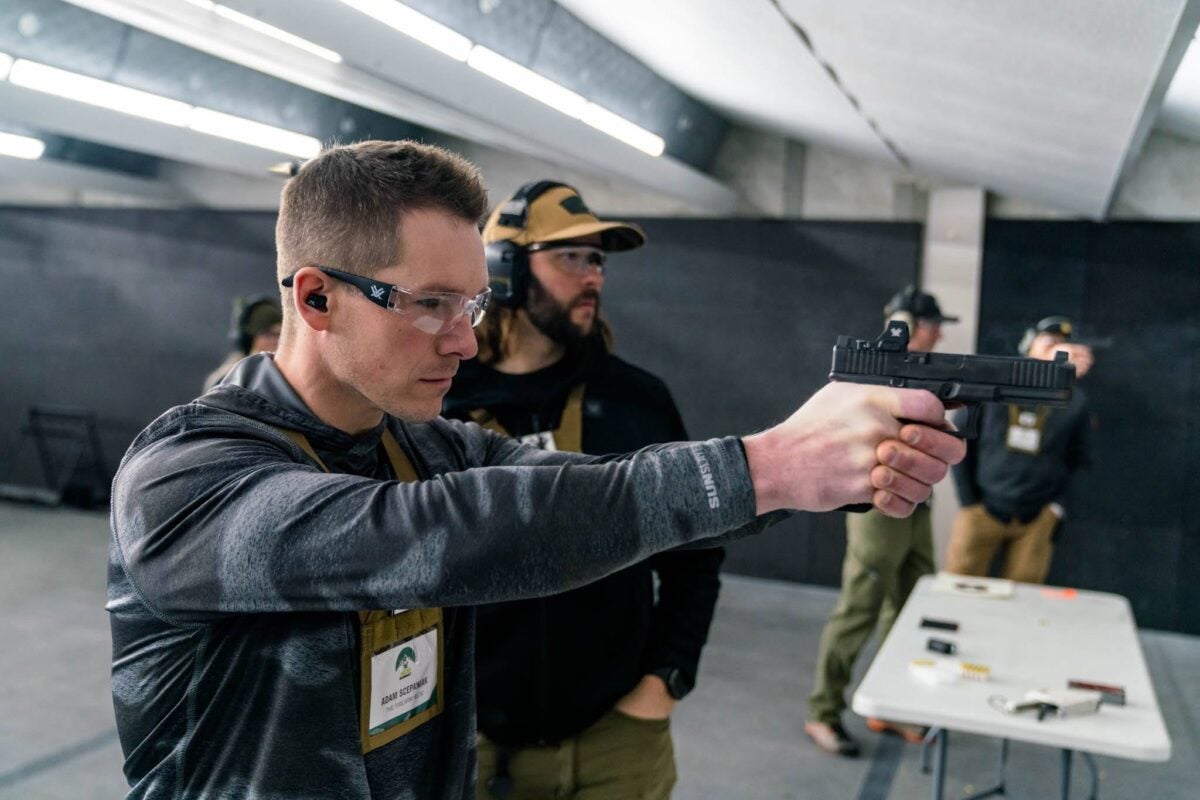Teaching Others About Firearms – They Want To Shoot Their Personal Gun
Phil Godding 04.04.23

We have a few non-negotiable rules in our classes, the first rule being safety first. We don’t want a negligent discharge on the range and we certainly don’t want a negligent discharge in the classroom, dining room, or wherever we teach. One way we address this is by providing all the guns and ammunition needed for instruction and certification; students can elect to use a personal gun if they desire.
Upside: We know the guns are empty (but we double- and triple-check every time one gets handled). We know where the ammo is (safely locked in a truck outside the building).
Teaching Others About Firearms on AllOutdoor
- Teaching Others About Firearms – What to Do with a Malcontent or Rascal
- Teaching Others About Firearms: Buying Branded vs Unbranded Gun Tools
- Teaching Others About Firearms – Building your 1st Mobile Hunting Blind
- Teaching Others About Firearms – Are You Hearing That?
We like to have students handle a variety of guns (especially new shooters). Actions are open and their first task is to figure out and then tell one of the instructors how they would approach the weapon if they found it laying on the table at a neighbor’s house. Is it loaded? How do you know? Where is the safety? How do you open the action? They also need to get the “feel” of the various weapons we have on the table. Heavy? Light? How many fingers are hanging off the handle?
What the students don’t know is we are watching and critiquing them the whole time they are handling the sample guns. We caution about sweeping, where the trigger finger is at all times and ask them to always keep the sample guns pointed in a safe direction. Most students are totally fine with this and easily corrected. See my earlier article about those who are not totally fine with safety. Watching, critiquing, coaching, and advising are all part of an instructor’s job.
The down side: This instructor approach requires an investment in weapons with different actions, weights, and sighting options. The last couple of years ammo acquisition has modified some of our offerings, but I’m learning to reload some calibers to reduce costs (don’t get me started on the lack of primers).
Another approach (and certainly less costly) is to have each student bring a personal gun and ammo. This routine should include an immediate safety check making sure ammo is not present – and if ammo is discovered to be present – a plan on how to make the weapon safe and the ammo handled safely. This is not an emergency – this is a teachable moment. No yelling. No harrumphing. Just a teachable moment. By making this a teachable moment we can critique what has happened and then demonstrate safe handling skills. [In my world the instructor makes the gun safe THEN the student copies the actions.]
We are totally fine with students bringing a personal gun. The student and I work together to prove the gun is unloaded and the action remains open. If they bring their own gun they usually want to provide their own ammo. The routine should include an immediate safety check making sure ammo is not present – and if ammo is discovered to be present – a plan on how to make the weapon safe and the ammo handled safely. [The clever reader may have noticed redundancy in the last two paragraphs – redundancy is intentional.] We generally do not allow students to handle another student’s personal gun – again for safety reasons. There are times when a student’s weapon is worth noting and demonstrating, but again, the instructor does the handling to made sure everything is done safely. The best part of this approach is also the critiquing and demonstrating safe handling skills in front of all the students. [In my world the instructor makes the gun safe THEN the student copies the actions.] Did I already say that? Working across a variety of weapons will also aid in generalization of what is being taught.
Our students only handle what we understand, we know is unloaded, and are comfortable with using. No mosquito guns or .50 caliber guns because my hands simply can’t handle them comfortably. The critique time begins with some quick observations about the relative match of the gun owner and their personal gun. Here are some encounters that happened to me, but I’m sure you have had some of your own experiences:
- Older female plops her purse on the shooting line and pulls out a shiny semi-auto and announces “I thought it was cute, so my husband bought it for me, but I can’t find ammo and now realize even if I had ammo I can only hold it with two fingers.” A mismatch waiting to go wrong.
- Younger male brings out a Desert Eagle 50 and asks if anyone wants to be the first to shoot it. He had it for several months, but was too afraid to shoot it. Would I be the first to try it? Nope. He got off one round at the firing line and then switched to one my .22s for the remainder of his shooting test. My guess is that he traded that gun in for something less fearsome later that day. A mismatch averted because the young man admitted he bought it more for machismo than self-defense – not a good combination.
- A middle-aged man brings out his newly acquired (from a private party) Snake Gun and I quickly notice a screw under the cylinder was “buggered up.” He had owned and used the gun for several years and had never noticed the problem. It was time to assess the gun for range worthiness. After careful assessment it became clear that only one screw had been messed up and had not actually been removed (half the slotted screw head was broken off). Lock up was tight. Hammer and trigger were perfect. Dry firing produced no hiccoughs. Furthermore, he had fired it in this condition many times so we moved into the teachable moment exercise. We had some time on our hands so it was a good opportunity to talk about misfires, hang-fires, squibs. A standard load downrange was followed by an inspection to look for changes – and all was well. Nonetheless, he promised to head to my favorite gunsmith to get the “buggered up” screw issue addressed. As instructors we need to take every opportunity to educate.
- A young man, fresh out of the military, came to the range with his boot gun. He was highly confident of his skills, until this semi-auto would not cycle. After closer inspection we found the action plugged with sock lint and other foreign matter. Mismatch in this case was with the student and care of the weapon. Lesson learned.
So where do these stories leave us? You need to have a written policy or practice on a personal gun in your teaching situations. As long as you have a policy or practice, and follow that practice, you will be in good shape. If you deviate from the typical or usual and someone gets hurt you might have a liability problem. A good middle ground practice might be to allow students to bring what they are comfortable with, but have a quick and respectful way to shift to one of your guns. Honestly, except for a handful of students there really hasn’t been much of an issue. The most frequent problem is a student trying to use a gun someone bought for them (think husbands and boyfriends) followed by neglected firearms full of old oil, carbon and pocket lint.
One family I taught brought an inherited gun safe full of unknowns. I had the family bring everything in their gun safe to my garage and I taught them how to make safe, clear, inspect, safely disassemble, clean, reassemble, and lubricate at least a half dozen firearms. I provided nitrile gloves, solvents, patches, and some gentle repetitive learning experiences. In many ways it was as much fun as being on the range because we could repeatedly make the guns safe, take actions apart and reassemble them until the handling of various actions started to get into their motor memory. I could see the family fear of guns melt away as they became proficient at breaking down and reassembling their weapons. I sent them home with a shopping list of things needed to prevent another garage cleaning session.
Sometimes there are more ways than one to get to “safety first.”
